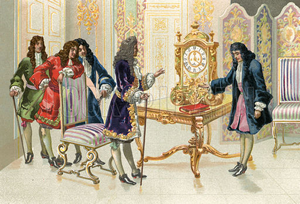Historical
Setting
 It is recorded that
a chance observation of a swinging church lamp led Galileo to find that
a pendulum made every swing in the same time, independent of the size
of the arc. He used this discovery in measuring time in his astronomical
studies. His experiments showed that the longer the pendulum, the longer
is the time of its swing. It is recorded that
a chance observation of a swinging church lamp led Galileo to find that
a pendulum made every swing in the same time, independent of the size
of the arc. He used this discovery in measuring time in his astronomical
studies. His experiments showed that the longer the pendulum, the longer
is the time of its swing.
Christiaan Huygens determined the mathematical relationship between the length of the pendulum
and the period of vibration when the arc of swing is small. He arrived
at the formula:

where
- T is the period,
or time for one complete swing,
- l is the length
- the distance from the point of suspension to the center of gravity
of the bob. Care has to be taken that the point of suspension is a
point - this can be achieved by clamping the string frimly between
two pieces of card.
- g is the acceleration
of gravity.
 In 1673, Huygens devised
a practicable means of making a pendulum control the speed with which
a clock mechanism runs. This led not only in the development of many types
of clock, but also in the application of pendulum control to other mechanisms. In 1673, Huygens devised
a practicable means of making a pendulum control the speed with which
a clock mechanism runs. This led not only in the development of many types
of clock, but also in the application of pendulum control to other mechanisms.
Problems and how
they were overcome
Metal pendulums expand
when heated (longer - therefore period increases!); to counteract the
effect of temperature changes, compensation pendulums have been devised,
many of them operating by the opposite expansion of different metals in
compound rods.
Forces acting on the
bob, such as air resistance and friction at the pivot point, affect its
swing - great care is taken to minimise friction or movement at the pivot
point and a pendulum in a vaccuum will not suffer air resistance (but
most pendulum clocks do not need such a great expense!)
|